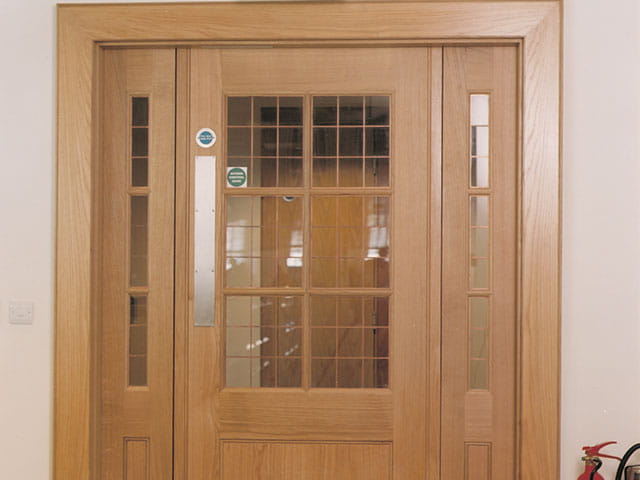Fire Resistance Ratings of Existing Fire Doors

By Engaged Expert
Peter BarkerPeter is a Technical Policy Manager working for many years in the field of passive fire protection, specializing in leading and supporting engineers producing engineering assessments of fire resisting construction products.
Senior Technical Manager, Peter Barker explains why Fire resistance ratings are critical to understanding the safety and integrity of building elements for construction, and this is equally important in the context of existing infrastructure.
More specifically, determining the resistance of operational fire doors in legacy buildings cannot be overlooked, as fire resisting doorsets help secure the means of escape and must therefore be considered as part of the risk assessment process. This is a legal duty placed upon responsible persons, as identified by the Regulatory Reform Fire Safety Order (RRFSO) 2005 (England and Wales).
Furthermore, the Fire Safety Act 2021 has recently clarified that flat entrance doors and fire doors within common areas of multi-occupancy residential buildings fall within the scope of the RRFSO, and must therefore be considered as part of the fire risk assessment.
It is also important to note that the Fire Safety (England) Regulations 2022 will come into force on 23 January 2023, and introduce additional legal duties for Responsible Persons of multi-occupancy buildings. Namely, there will be specific requirements related to fire resisting doors, such as providing information to residents about the fire doors within the building and conducting periodic checks.
Missing evidence
There is a key challenge facing these ‘responsible persons’ however. For buildings and flats that were built many years ago, fire doors within such developments may lack the records or markings to help identify provenance.
If there are no records or means of tracing the doors origins, it is impossible to locate supporting evidence. Establishing the fire resistance rating subsequently becomes a complex matter of considered opinion, as many hidden construction details may exist that cannot be easily identified by visual inspection.
On top of identifying the doors, maintenance is another issue to contend with. There may be a lack of records for alterations made to the doors since they were installed, including replacement components or performative additions such as security hardware. It is worth noting that maintenance of fire safety provisions, such as fire resisting doorsets, is a legal duty placed on the responsible person under article 17 of the RRFSO.
As such, the fire resistance rating of the door may be indeterminable. Without a paper trail and third-party certification or manufacturers’ markings, the door will need to be duly inspected and assessed.
Worthy replacements
If the fire resistance rating of the fire doors has been deemed inadequate or cannot be determined, suitable fire-resisting doorsets would need to be specified and installed as replacements in both cases.
It is vital that the performance of fire resisting doorsets is underpinned by suitable and sufficient test evidence. However, a test report will only provide information on the design (or designs) that were tested. As a standalone, it does not provide any added assurance as to whether the product being supplied to market has been constructed according to the details given in the test report, or whether changes to the design are acceptable.
As such, it is recommended that any replacement product is supplied by a manufacturer that operates under the requirements of an accredited third party certification scheme.
Accredited third-party certification schemes for construction products are voluntary but valuable, as they provide confidence to consumers and other interested parties that the products conform to outlined requirements. More specifically, their ability to provide the required level of fire resistance.
Third party certification schemes introduce additional conformity assessment activities beyond the mandatory testing requirement such as:
1. Sampling of the product to independently verify the construction of the product before it is tested
2. Periodic inspections of factory production control to verify ongoing manufacturing processes and to check that the materials being used are the same as the originally tested specimen
3. Marking and labelling requirements to identify the performance of the doors and as well as the manufacturer, which is useful for ongoing risk assessment and maintenance activities
4. Periodic audit testing of construction to verify the ongoing performance of the product
The scope of a third-party certified product family will be based on suitable and sufficient test evidence, typically extended through an assessment written by an organisation with the necessary expertise. For example, a UKAS accredited laboratory that is qualified to undertake the relevant test and subscribes to the principles of the Passive Fire Protection Forum (PFPF) Guide to Undertaking Technical Assessments of Construction Products Based on Fire Test Evidence.
Depending on the doorsets use and location within the building, there may be other performance characteristics to consider in addition to fire resistance performance. It is important to verify whether these additional performance characteristics are covered by the certification for the doorset (e.g. security and smoke control), as any alterations to the doorset (e.g. adding security hardware) could fall outside the established scope and undermine the performance of the doorset altogether.
The installation of replacement doorsets should not be forgotten as part of this process. In far too many instances, doorsets are replaced only for the installation methods to undermine the fire resistance rating - rendering the exercise futile and expensive, as well as non-compliant and dangerous. Accredited third party certification schemes also exist for the installation of doorsets and provide added assurance on the quality and compliance of the installation.
Best practice
With all the above considered, it is clear that building owners and managers must be diligent in regard to fire resistance ratings of existing fire doors. If doorsets prove indeterminable, it is vital that replacements are capable of meeting the performance requirements. Such procedures must be underpinned by suitable and sufficient test evidence, ideally third-party certified for optimum safety.
Find related Resources


